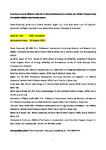Escalation of care in children at high risk of clinical deterioration in a tertiary care children’s hospital using the Bedside Pediatric Early Warning System
| dc.contributor.author | Gawronski, O | |
| dc.contributor.author | Latour, Jos M | |
| dc.contributor.author | Cecchetti, C | |
| dc.contributor.author | Lula, A | |
| dc.contributor.author | Ravà, L | |
| dc.contributor.author | Ciofi degli Atti, ML | |
| dc.contributor.author | Dall’Oglio, I | |
| dc.contributor.author | Tiozzo, E | |
| dc.contributor.author | Raponi, M | |
| dc.contributor.author | Parshuram, CS | |
| dc.date.accessioned | 2022-08-18T18:36:32Z | |
| dc.date.issued | 2022-09-07 | |
| dc.identifier.issn | 1471-2431 | |
| dc.identifier.issn | 1471-2431 | |
| dc.identifier.other | 530 | |
| dc.identifier.uri | http://hdl.handle.net/10026.1/19549 | |
| dc.description.abstract |
Abstract Background Escalation and de-escalation are a routine part of high-quality care that should be matched with clinical needs. The aim of this study was to describe escalation of care in relation to the occurrence and timing of Pediatric Intensive Care Unit (PICU) admission in a cohort of pediatric inpatients with acute worsening of their clinical condition. Methods A monocentric, observational cohort study was performed from January to December 2018. Eligible patients were children: 1) admitted to one of the inpatient wards other than ICU; 2) under the age of 18 years at the time of admission; 3) with two or more Bedside-Paediatric-Early-Warning-System (BedsidePEWS) scores ≥ 7 recorded at a distance of at least one hour and for a period of 4 h during admission. The main outcome -the 24-h disposition – was defined as admission to PICU within 24-h of enrolment or staying in the inpatient ward. Escalation of care was measured using an eight-point scale—the Escalation Index (EI), developed by the authors. The EI was calculated every 6 h, starting from the moment the patient was considered eligible. Analyses used multivariate quantile and logistic regression models. Results The 228 episodes included 574 EI calculated scores. The 24-h disposition was the ward in 129 (57%) and the PICU in 99 (43%) episodes. Patients who were admitted to PICU within 24-h had higher top EI scores [median (IQR) 6 (5–7) vs 4 (3–5), p < 0.001]; higher initial BedsidePEWS scores [median (IQR) 10(8–13) vs. 9 (8–11), p = 0.02], were less likely to have a chronic disease [n = 62 (63%) vs. n = 127 (98%), p < 0.0001], and were rated by physicians as being at a higher risk of having a cardiac arrest (p = 0.01) than patients remaining on the ward. The EI increased over 24 h before urgent admission to PICU or cardiac arrest by 0.53 every 6-h interval (CI 0.37–0.70, p < 0.001), while it decreased by 0.25 every 6-h interval (CI -0.36–0.15, p < 0.001) in patients who stayed on the wards. Conclusion Escalation of care was related to temporal changes in severity of illness, patient background and environmental factors. The EI index can improve responses to evolving critical illness. | |
| dc.format.extent | 530- | |
| dc.format.medium | Electronic | |
| dc.language | en | |
| dc.language.iso | en | |
| dc.publisher | BioMed Central | |
| dc.subject | Escalation of care | |
| dc.subject | Pediatric | |
| dc.subject | Track and trigger tool | |
| dc.subject | BedsidePEWS | |
| dc.subject | PEWS | |
| dc.subject | Intensive care | |
| dc.subject | Urgent admission | |
| dc.title | Escalation of care in children at high risk of clinical deterioration in a tertiary care children’s hospital using the Bedside Pediatric Early Warning System | |
| dc.type | journal-article | |
| dc.type | Journal Article | |
| dc.type | Observational Study | |
| plymouth.author-url | https://www.webofscience.com/api/gateway?GWVersion=2&SrcApp=PARTNER_APP&SrcAuth=LinksAMR&KeyUT=WOS:000850790400002&DestLinkType=FullRecord&DestApp=ALL_WOS&UsrCustomerID=11bb513d99f797142bcfeffcc58ea008 | |
| plymouth.issue | 530 | |
| plymouth.volume | 22 | |
| plymouth.publication-status | Published online | |
| plymouth.journal | BMC Pediatrics | |
| dc.identifier.doi | 10.1186/s12887-022-03555-0 | |
| plymouth.organisational-group | /Plymouth | |
| plymouth.organisational-group | /Plymouth/Faculty of Health | |
| plymouth.organisational-group | /Plymouth/Faculty of Health/School of Nursing and Midwifery | |
| plymouth.organisational-group | /Plymouth/REF 2021 Researchers by UoA | |
| plymouth.organisational-group | /Plymouth/REF 2021 Researchers by UoA/UoA03 Allied Health Professions, Dentistry, Nursing and Pharmacy | |
| plymouth.organisational-group | /Plymouth/Research Groups | |
| plymouth.organisational-group | /Plymouth/Research Groups/Institute of Health and Community | |
| plymouth.organisational-group | /Plymouth/Research Groups/Plymouth Institute of Health and Care Research (PIHR) | |
| plymouth.organisational-group | /Plymouth/Users by role | |
| plymouth.organisational-group | /Plymouth/Users by role/Academics | |
| dc.publisher.place | England | |
| dcterms.dateAccepted | 2022-08-16 | |
| dc.rights.embargodate | 2022-9-21 | |
| dc.identifier.eissn | 1471-2431 | |
| dc.rights.embargoperiod | Not known | |
| rioxxterms.versionofrecord | 10.1186/s12887-022-03555-0 | |
| rioxxterms.licenseref.uri | http://www.rioxx.net/licenses/all-rights-reserved | |
| rioxxterms.type | Journal Article/Review |


